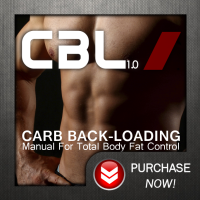In the main Carb Back Loading manual, the idea of training first thing in the morning is discussed in great detail. Ideally, you’ll be able to train in the late afternoon or early evening, at around 5 PM or thereabouts. That’s the “sweet spot” that helps CBL take advantage of your body’s natural circadian rhythms. It’s at least somewhat within the ballpark of when many people finish work for the day, and it gives you ample time before you go to sleep to replenish your glycogen stores with a nice, big back-load. Of course, life doesn’t always imitate the ideal circumstances suggested by your favorite nutrition book, so accommodations have to be made.
What we’ve found—and what’s covered in the book—is that it’s possible to train at other times during the day and still experience great results from CBL if you’re willing to make a few minor modifications to the plan. This is great news for a high percentage of CBL users, because training in the early evening or late at night isn’t always an option.
Fasted Morning
The trouble with rolling out of bed and going straight to the gym is that this approach isn’t always the best alternative, either. For many people, getting there immediately isn’t possible when you need to get your kids dressed and ready for school, you’re commuting to a gym that’s close to where you work—and, hopefully, showering there before you inflict your post-workout self on your colleagues—or when you’re a powerlifter working with very heavy loads. In the last case, it’s definitely not a good idea to squat or deadlift using maximal weight so soon after waking up, so something’s got to give.
For these people, there has to be something of a window in the morning—a grace period where you can back-load at night, drink coffee, and still enjoy all the benefits of CBL-influenced early morning training. The question most people ask obviously pertains to when, once you’ve woken up, this period ends. In other words, if you have to wait too long to train after you’ve woken up, is it going to be a problem?
The Glycogen Game
When you back-load the night before a heavy morning training session, you’re doing so because you’re refilling your glycogen reserves. That’s what the nightly back-load is designed to do. You won’t be tapping into those glycogen reserves until you go train, so the window to use them is pretty much wide open until the evening.
 Let’s say you do a big, carb-laden back-load right before you go to sleep, complete with a whole pizza, or some cherry turnovers. Within the first two hours after you’ve gone to sleep, your body will transition from using carbs to using almost exclusively fatty acids. This process will continue all the way through until the next day, provided you don’t screw up the process by eating carbs before you train. The window here is very large, and all you have to do to avoid screwing it up is stick to coffee or a caffeine supplement. Don’t do anything else.
Let’s say you do a big, carb-laden back-load right before you go to sleep, complete with a whole pizza, or some cherry turnovers. Within the first two hours after you’ve gone to sleep, your body will transition from using carbs to using almost exclusively fatty acids. This process will continue all the way through until the next day, provided you don’t screw up the process by eating carbs before you train. The window here is very large, and all you have to do to avoid screwing it up is stick to coffee or a caffeine supplement. Don’t do anything else.
Now, if you wait too long to train, you’re veering into what’s referred to in the book as “middle training.” Middle training isn’t exactly bad, per se, but it’s not optimal, either. It doesn’t have any of the “extras” we’re able to take advantage of with evening and fasted morning training. There’s nothing there we can leverage. Training in the middle of the day isn’t optimal for GLUT4 translocation for your carbs at night. This is because, again, you can’t really do anything extra with carbs for a bigger anabolic boost. See the main Carb Back-Loading manual for more on all of this.
The AM Window
If you can keep everything—your coffee and then your training—contained within a two-hour window after you wake up, however, you’ll still find yourself in a pretty optimal time period. An easy way to remember this is to simply make sure you’re getting your training in within twelve hours of going to sleep. Consider that twelve-hour window your cutoff time for keeping everything optimal—and if you’re managing to get eight hours of sleep, then going to work after you train, chances are you won’t be training for more than an hour anyway. It shouldn’t be too difficult to get everything to fall within this twelve-hour window.
There’s an additional degree of importance to this, because it’s also the window for autophagy to turn on and start becoming a negative influence. Autophagy is a catabolic process by which cells “clean themselves out,” and you don’t want to play around with it in the morning. You’re also going to get something of a catabolic burst from your resistance training at this point, too, so the only thing you really need to worry about here is making sure you have an opportunity to eat. If you’re training at this time of the morning, not eating will essentially give you a double catabolic response, which is something you’ll want to avoid.
Hopefully, this will clear up any confusion you have about early morning training while you’re on a Carb Back-Loading plan. Yes, there are rules, and optimal times to do everything, but provided you get moving in the morning and get to the gym within that twelve-hour window, there’s no real “countdown of death” that, once down to zero, negates the effects of your back-load the previous night.








Recent Comments